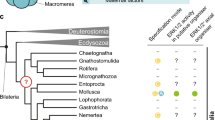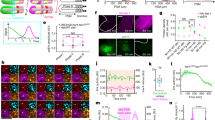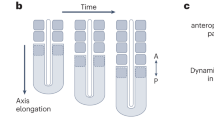Abstract
Segmented animals are divided into a longitudinal array of developmentally homologous subunits known as metameres. The embryonic origin of the segmental body plan has been studied in a variety of organisms, with particular emphasis on the mechanisms underlying the delineation of the individual metameres1–3 and their secondary diversification4. I have examined the embryonic events which determine the total number of segments in the glossiphoniid leech Helobdella triserialis. The germinal band of the leech consists of chains of segmental founder cells, called blast cells, and is normally reduced to 32 segments by the degeneration of supernumerary blast cells located at its caudal end5,6. By using a novel technique for selective cell ablation, the segmental register of the four ectodermal cell lines can be altered so that lineally identifiable blast cells take part in the formation of ectopic segments. I show here that the survival or death of ectodermal blast cells is determined by position independent of their cell lineage identities, implying that the final number of segments is imposed on the ectoderm by interactions with the other embryonic tissues.
This is a preview of subscription content, access via your institution
Access options
Subscribe to this journal
Receive 51 print issues and online access
$199.00 per year
only $3.90 per issue
Buy this article
- Purchase on Springer Link
- Instant access to full article PDF
Prices may be subject to local taxes which are calculated during checkout
Similar content being viewed by others
References
Lawrence, P. A. J. Embryol. exp. Morph. 30, 681–699 (1973).
Hamilton, L. J. Embryol. exp. Morph. 22, 253–264 (1969).
Bellairs, R. J. Embryol. exp. Morph. 51, 227–243 (1979).
Struhl, G. Nature 293, 36–41 (1981).
Zackson, S. L. Cell 31, 761–770 (1982).
Fernandez, J. & Stent, G. S. J. Embryol. exp. Morph. 72, 71–96 (1982).
Fernandez, J. Devl Biol. 76, 245–262 (1980).
Stent, G. S., Weisblat, D. A., Blair, S. S. & Zackson, S. L. in Neuronal Development (ed. Spitzer, N. C.) 1–44 (Plenum, New York, 1982).
Weisblat, D. A., Sawyer, R. T. & Stent, G. S. Science 202, 1295–1298 (1978).
Weisblat, D. A., Zackson, S. L., Blair, S. S. & Young, J. D. Science 209, 1528–1530 (1980).
Weisblat, D. A., Harper, G., Stent, G. S. & Sawyer, R. T. Devl Biol. 76, 58–78 (1980).
Blair, S. S. Devl Biol. 89, 389–396 (1982).
Blair, S. S. Devl Biol. 95, 65–72 (1983).
Weisblat, D. A. & Blair, S. S. Devl Biol. (in the press).
Spikes, J. D. in Photophysiology Vol.3 (ed. Giese, A. C.) 33–64 (Academic, New York, 1968).
Sulston, J. E., Albertson, D. G. & Thomson, J. N. Devl Biol. 78, 542–576 (1980).
Sulston, J. E. & White, J. G. Devl Biol. 78, 577–597 (1980).
Author information
Authors and Affiliations
Rights and permissions
About this article
Cite this article
Shankland, M. Positional determination of supernumerary blast cell death in the leech embryo. Nature 307, 541–543 (1984). https://doi.org/10.1038/307541a0
Received:
Accepted:
Issue Date:
DOI: https://doi.org/10.1038/307541a0
This article is cited by
Comments
By submitting a comment you agree to abide by our Terms and Community Guidelines. If you find something abusive or that does not comply with our terms or guidelines please flag it as inappropriate.



